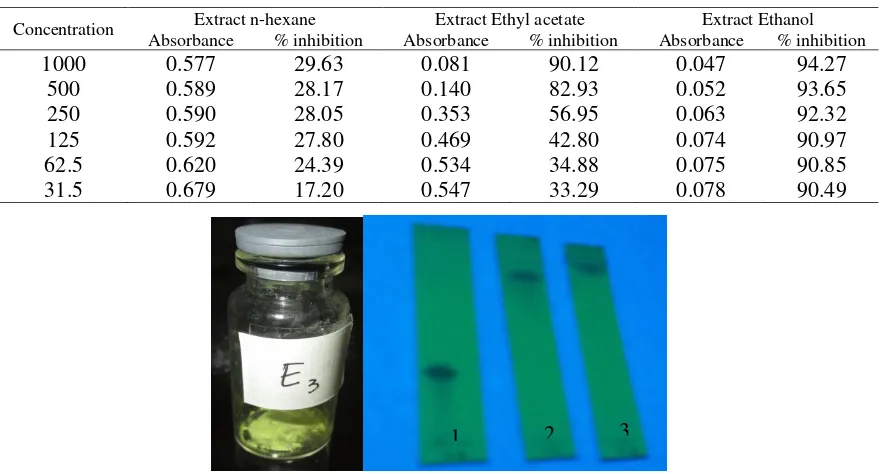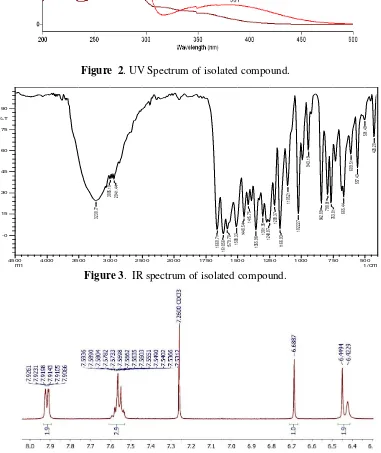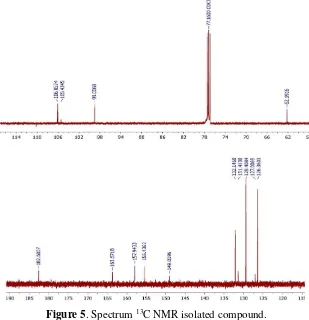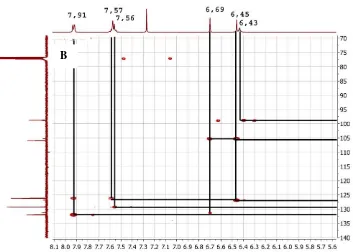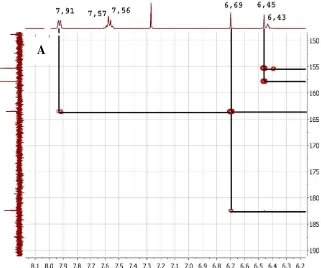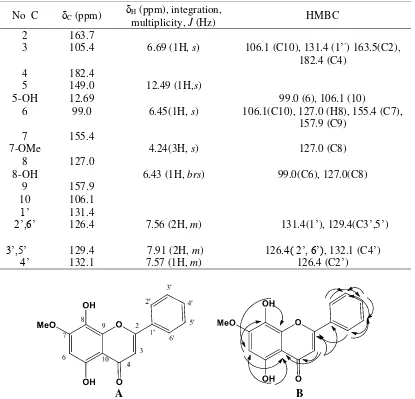Flavon Compound from The Ethyl Acetate Extract of The Stem of Supit (Tetracera indica Merr.)
Muharni*, Elfita, Riska Adillah, Heni Yohandini, Julinar
Department of Chemistry, Faculty of Mathematics and Natural Sciences , Sriwijaya University, Palembang, Indonesia
*email: muharnimyd@yahoo.co.id
Received November 20, 2017; Accepted March 21, 2018; Available online May 31, 2018
ABSTRACT
Tetracera indica Merr. in Musi Banyuasin, is one of the traditional medicine used by the community for the treatment of kidney stone disease and gout, but this claim is not recorded in the treatment of kidney stones and gout in Indonesia. In this study, isolation of antioxidant compound from ethyl acetate extracts of supit (Tetracera indica) was done. The isolation was carried out through step gradient polarity extraction, and separated and purified by chromatography technique. The determination of the structure of the isolated compound was performed by spectroscopy method including UV, IR, and NMR 1D and 2D, and antoxidant activity was determined by DPPH method. An active antioxidant compound was isolated from ethyl acetate extract in form of yellow solid (15 mg). Based on spectroscopic analysis the isolated compound was 5,8-dihydroxy-7-methoxyflavone. The compound showed strong antioxidant activity (IC50 8.25 μg/mL) higher than standard ascorbic acid (IC5011.3 μg/mL). This data concluded that efficacy of supit (Tetracera indica) for the treatment related to antioxidant activity (uric acid) is proven by the identification of one antioxidant compound of this plant.
Key word: Flavon, ethyl acetate extract, Tetracera indica, antioxidant
INTRODUCTION for generations. Indonesian herbal medicines are used based on empirical practice: diseases preventive (48.9%) (Hanafi et al, 2005). Although modern medicine has grown tremendously in Indonesia, but traditional medicine is still very popular in rural as well plants used for traditional treatment.
In previous research has been done exploration and inventory of medicinal plants and their utilization in society based on local resources. One of them is the ethnic Musi in Musi Banyuasin district of South Sumatra. In research of medicinal plants and herbal medicine has been identified 95 species of medicinal plants (Yustian, Muharni, Sukarmi,
Zulaicha, and Arbi, 2012). From the 20 selected plant, 9 species of them are traditionally used for the treatment of diseases atherosclerosis, diabetes , prostate, gout, and kidney stones. These types of diseases are related to free radical activity (Paravicini and Touyz, 2008). In vitro antioxidant activity test of 9 selected plant extracts is one of them is supit stems, showed high antioxidant activity with value of % inhibition 69.6% at test concentration 1000 ppm. Based on literature study of extracts that showed antioxidant activity> 50% categorized as active source of antioxidant compound (Chaudhary, Bhandari, and Pandurangan, 2011; Muharni, Fitrya, and Nurmaliana, 2016).
2013). The limited ingredients available medicines has prompted researchers to explore the potential of nature to find new bioactive compounds.
Chemical compounds from leaf of supit (Tetracera indica) has been reported 4 terpenoid compounds: β-sitosterol, lupeol, Betuline, betulinic acid and 6 compounds flavonoid 5, 7-dihydroxy-8-methoxylavone or another name (Wogonin), 5, 7,8-tryhydroxyflavone, isocutellarein methyl ether, kaemferol, quersetin, tetrokrisin (Dogarai, 2011). The methanol extract leaf of the supit showed activity as antidiabetic (Ahmed, Dogarai, Amiroudine, Taher, Latip, Umar, and Muhammad, 2012). Other research Fitrya, Muharni, and Maretha (2012) reported one phenolic compound from ethyl acetate extract of fruit.
In another study of Tetracera indica leaf extract containing flavonoid wagonin compound was active as an antibacterial (Lima, Lemos, and Conserva, 2014). Abdullah, Ismail, Jamaludin, and Mashim (2013) reported that the stems of supit show activity as antihiperuricemia, antidiabetic and anti-inflammatory and two compound has been reported of stem supit that is betulinic acid and 5,7-dihydroxyl-8-methoxyflavone. In this paper will be reported antioxidant compound active by DPPH method from ethyl acetate extract stem of supit.
EXPERIMENTAL SECTION
Material
The stem of Tetracera indica (2 kg) were collected from Ngulak I village Musi Banyuasin South Sumatera in June 2017. The botanical identification of the samples was confirmed by Dr. Laila Hanum. A voucher specimen (number VIC 2701) was deposited at the Herbarium Department Biology Sriwijaya University. Material for isolation: silica gel 60 (70 -230 mesh.), thin layer chromatography (TLC) using Merck (Art.5554), silica gel G 60 (70 – 230), methanol p.a, n-hexane p.a, ethyl
acetate p.a, chloroform p.a acetone p.a, distilled water. Reagent for antioxidant activity: DMSO (dimethyl sulfoxide), DPPH (1,1-diphenyl-2-picrylhydrazyl), and ascorbic acid.
Instrumentation
The apparatus in the research were rotary evaporator R-114 Buchi, column
chromatography(CC), ultra-violet lamps CAMAG 254 nm, radiation (λ = 254 and 365 nm). Fisher Jhon melting point apparatus, spectrophotometer ultraviolet Beck DU-7500. FTIR-Perkin Elmer, NMR JEOL JNM ECA-500 spectrometer. UV–visible spectrophoto meter using a single beam provided by Shimadzu-UV mini 1240 instrument, and commonly used glassware in the organic laboratory.
Preparation of Extracts
The stem of Tetracera indica were dried at 30 °C for 20 days with continuous moisture monitoring. After the material was completely dry, it was pulverized in a knife grinder, obtained 550 g of sample. The dried stem bark were subjected to exhaustive extraction in maceration apparatus using an increasing polarity solvent system, with n-hexane, ethyl acetate and ethanol as solvents each for 24 h. The extracts were then concentrated at reduced pressure used Rotary evaporator. Each of the extracts was tested antioxidant activity.
Evaluation of Antioxidant Activity of Each Extract
The antioxidant activity test was performed using DPPH radical-scavenging activity (Selvi, Joseph, and Jayaprakasha, 2003; Tuanjai, Supalax, Thawatchai, and Wittaya, 2011). The concentration series for extract :1000, 500, 250, 125, 62.5 and 31.25 1000 µg/mL (in DMSO) was prepared. 0.2 mL aliquot of sample solution was mixed with 3.8 mL of DPPH (0.5 mM in methanol) where 1.98 mg DPPH was placed on a 100 mL volumetric flask then add methanol until the volume 100 mL. This mixture was shaken at room temperature for 30 min.
The absorbance of the mixture was then measured by UV-Vis spectrophotometer at λmax
Table 1. Antioxidant activity of each extract
Concentration Extract n-hexane Extract Ethyl acetate Extract Ethanol
Absorbance % inhibition Absorbance % inhibition Absorbance % inhibition
1000 0.577 29.63 0.081 90.12 0.047 94.27
Isolation and Purification Antioxidant Compound from Ethyl Acetate Extract
Ethyl acetate extract (3.5 g) was separated by silica column chromatography using silica G 60 F254 (230-400 mesh), eluted
with gradient polarity mixtures of hexane- ethyl acetate ( 9: 1 - 5 : 5 ) were collected. Base on TLC analysis merged into six fraction F1 ( vials 1 – 5; 25 mg ), F2 ( vials 7– 23; 1300 mg), F3 (vials 26 – 67; 250 mg ), F4 (vials 68 – 80; 500 mg ), F 5( vials 81 – 84; 100 mg), and F 6 ( vials 85 – 95; 700 mg). From the selected fractions, the 4th fraction (500 mg)
was further purified by re-chromatography using silica gel 60 (70 – 230 mesh), eluted with gradient polarity mixtures of n-hexane-ethyl acetate (9:1 - 7:3) each 150 mL.
mg). Fractions F 4.3.1 obtained yellow solid (15
mg) and after analyzed with TLC showed one spot so it was pure compound.
Elucidation Structure
The structure of the isolated compound was elucidated using UV, IR, NMR 1D( 1H
and 13C NMR, DEPT), and NMR 2D (HMQC,
and HMBC) spectroscopy and by comparison with data from the literature.
Evaluation Antioxidant Activity of Isolated Compound acetate 3,50 g and ethanol extract 3.7 g. Each extract, has been done antioxidant activity test with varying concentration (Table 1). Mariod, Matthaus and Hussein, (2008) state that the value of antioxidant activity is determined based on the value of percentage inhibition, the higher the value of the inhibition, the higher the antioxidant activity.
Table 1 showed that at the same concentration 1000 μg / mL, the ethanol extract showed the highest activity with inhibition 94.27% followed by ethyl acetate extract with inhibition 90.12%. Meanwhile, n-hexane extract only gives an inhibition of
29.63%. Extracts are categorized potent containing antioxidant compounds when its have percent inhibition > 50% at a concentration of 1000 μg/mL (Chaudhary et al., 2012). Based on this data it is stated that the extract of ethyl acetate and ethanol extract from stems of supit (Tetracera indica) potentially contain antioxidant compounds. The Compounds that exhibit antioxidant activity generally provide fluorescent under UV light at a wavelength of λ 365 nm. Ethyl
acetate extract after separation and purification a compound was isolated from the ethyl acetate extract of steam T. indica. The isolated compound was as a yellow solid (15 mg). The purity test of the isolated compound was carried out by TLC analysis using various eluents : n-hexane : ethyl acetate (9 : 1 ; 5 : 5) and EtOAC : MeOH (9.5 : 1.5) showed a single spot on the UV lamp at λ 365 nm (Figure 1).
Figure 2. UV Spectrum of isolated compound.
500
Figure 3. IR spectrum of isolated compound.
The purity test of isolated compound were also conducted with measurement of the melting point. The measurement result obtained isolation compound have melting point is 203-205 °C, the narrow melting point range (≤ 2 °C) showed the isolated compound was pure. Determination Structure of The Isolated Compound
Structural determination was done through spectroscopic analysis using several methods of spectroscopy UV, IR, NMR 1D (
1H NMR, 13C NMR, dan DEPT) and NMR 2D
(HMBC, HMQC). The UV spectrum (Figure 2) shows the maximum absorption at λmax 275 nm which is the absorption for the conjugated C = C bond. The addition of MeOH as a shear reagent causes a maximum wavelength shift to λmax 284 nm, indicating the presence of OH phenolic. The measurement of the infrared spectra of the isolated compound with KBr pellet shows the absorption on νmax cm-1
3230.77 with a wide peak shape indicating that the OH group having hydrogen bond, 1660.71 (conjugated C=O ), 1415.76; 1508.33; dan 1448.54 (C=C conjugation), and 1166.93 (C-O ether). Based on the absorption of IR, it is suspected that the isolated compound is a flavonoid group in which literature study the
IR for flavonoids such as morelloflavon as reported by Muharni, Elfita, and Amanda (2011) provides absorption on ʋmaks 3263
(OH group). 1643 (conjugated C=O), ; 1552; 1514; 1439 (C=C aromatic) and 1180 cm-1
(C-O ether).
The 1H NMR spectrum of the isolated
compound (Figure 4) show the proton signal of methoxy at δH 4.04 (3H, s) and the signal of
the aromatic proton at the δH 6.0-8.0 ppm . Signals at δH 6.43 (1H, brs) with widened
peaks are signals for phenolic OH. Signals at δH 6.45 ppm (1H, s) and 6.69 (1H, s) are 2
non-split aromatic protons, 7,54 - 7,56 (3H, m) are 3 proton aromatics that split with protons at δH 7.91 (2H, dd J = 3.85) and signal at δH
12.49 (1H, s) are signal for proton OH chelate. The 13C NMR spectrum of the isolated
compound showed 14 signals. Signal δC 62.2
ppm is characteristic signal for methoxy carbon. Signals at δC 99.00 - 165 ppm are
signals for C SP2 from aromatic carbon. The
signal at δC 182.4 ppm is a signal for C
carbonyl in the form of a ketone. In HMQC spectrum (Figure 6) showed proton methoxy at δH 4.04 ppm bound to carbon δC 62.2 ppm
and on spectrum of HMBC showed correlation with carbon at δC 127.0 ppm.
Figure 6.Spectrum HMQC at δH 3.2 –8.4 δC 60 -135 ppm (A) and HMBC at δH 5.6 -8.1 δC 700
-140 ppm (B)
The HMQC spectrum also showed proton at δH 6.45 ppm (1H, s) and δH 6.69 (1H,
s) respectively bound to carbon at δC 99.0 ppm
and δC 105.4 ppm. In the HMBC spectrum
(Figure 6) showed protons at δH 6.45 ppm
(1H, s) correlated with carbon at δC
106.1(C10), 127.0 (H8) 155.4 (C7), 157.9 ppm (C9). Meanwhile the proton at δH 6.69 (1H, s)
correlated with carbon at δC 106.1 (C10), 131.4
(1') 163.5 (C2), 182.4 ppm (C4). This indicates the carbon at δC 106.1 ppm was
located between the carbon at δC 99.0 and
105.4 ppm.
The HMQC spectrum also showed proton at δH 7.56 (2H) ppm, 7.57 (1H, s) and
7.91 ppm (2H) respectively bound to carbon respectively δC 126.4 132.2 and 129.4 ppm.
Based on the integration of the aromatic proton δH 7,56 and 7,91 respectively 2 protons then it is assumed the carbon signals at δC 126.4 and
129.4 ppm were signals each representing 2 carbon.
A
Figure 7.Spectrum HMBC at δH 6.2 – 8.1 ppm and δC 12.2 – 12.9 ppm and δH 100 –165 ppm.
Based on this HMQC data the number of carbon signals is 16 signals and the compound has an aromatic group in the form of mono substitution. In the HMBC spectrum the proton signals at δH 7.56 ppm correlate with
the carbon at 131.4(1’), 129.4 ppm (C3’,5’), meanwhile the signal at δH 7.91ppm Showed
correlated with carbon at δC 126.4( 2’,6’),
132.1 ppm (C4’). This suggests that the protons at δH 7.56 and δH 7.91 ppm were in
adjacent C positions.
Furthermore, it was also seen in the HMQC spectrum where proton at δH 12.49
ppm bound to carbon at δC 163.76 ppm and on
A
the HMBC spectrum this proton visible correlated with carbon at δC 99.0; 105.4 and
157.9 ppm δC 99.0; 106.1 ppm. This indicates
that this hydroxyl proton is a chelated proton adjacent to a proton δH 6.45 ppm. The
correlation between proton and carbon is shown in Figure 8. Based on UV IR, NMR 1d and 2 D spectroscopy data, it was concluded that isolation compound was flavonoid 5,8-dihydroxy-7-methoxyflavone with molecular formula C16H12O5 with the structure shown in
Figure 8.
Antioxidant activity of isolated compound Antioxidant activity test was done by DPPH method with concentration variation 100, 50, 25, 12.5 and 6.75 ppm. Antioxidant activity is determined based on the value of% inhibition (Table 3). The higher the% inhibition, the stronger the antioxidant activity
Table 3 showed the higher the concentration of the test the smaller the absorbance and the percent inhibition value will also be higher. Based on the percentage of inhibition seen at a concentration of 6.25 μg / mL, the isolation compound results showed higher activity than the standard ascorbic acid. To determine the value of IC50, the plot curve between
concentration and the value of % inhibition based on the linear regression. Base on regression linear obtained equation shows that IC50value of the isolated compound is 8.25 μg
/ mL, while the ascorbit acid gives IC50 value
of 11.3 μg / mL. Based on this data concluded the efficacy of supit plants (Tetracera indica) for the treatment related to antioxidant activity (uric acid) is proven by the identification of one antioxidant compound of this plant. Isolatet compound is flavonoid group.
Table 2. Chemical shift data of proton and carbon of the 1H and 13CNMR spectra of isolation compound at 500 MHz for 1H and 125 MHz for 13C in CDCl
3.
No C C (ppm) H (ppm), integration,
multiplicity, J (Hz) HMBC
2 163.7
3 105.4 6.69 (1H, s) 106.1 (C10), 131.4 (1’’) 163.5(C2), 182.4 (C4)
4 182.4
5 149.0 12.49 (1H,s)
5-OH 12.69 99.0 (6), 106.1 (10)
6 99.0 6.45(1H, s) 106.1(C10), 127.0 (H8), 155.4 (C7), 157.9 (C9)
7 155.4
7-OMe 4.24(3H, s) 127.0 (C8)
8 127.0
8-OH 6.43 (1H, brs) 99.0(C6), 127.0(C8)
9 157.9
10 106.1
1’ 131.4
2’,6’ 126.4 7.56 (2H, m) 131.4(1’), 129.4(C3’,5’) 3’,5’ 129.4 7.91 (2H, m) 126.4( 2’,6’), 132.1 (C4’)
4’ 132.1 7.57 (1H, m) 126.4 (C2’)
A B
Table 3. Antioxidant activity of isolated compound
No Concentration Isolated compound Ascorbic acid
Absorbance % inhibition Absorbance % inhibition
1 100 0.017 94.74 0.032 94.2 antioxidant activity, such as for the prevention of coronary heart disease, hepatoprotective activity, anti-inflammatory, and anticancer (Kumar and Pandey, 2013).
The isolated compound 5,8-dihydroxy-7-methoxyplavone was known by another name wogonin and has been previously found on the leaf extract (Dogarai et al., 2011) and stem extract of Ttetracera indica (Abdullah et al., 2013), but is first reported as active antioxidant against DPPH radicals.
CONCLUSIONS
A flavon compound has been isolated from ethyl acetate extract of the stem of supit (Tetracera indica) and identified as 5,8-dihydroxy-7-methoxyplavone. This compound showed strong antioxidant activity by DPPH method with IC50value 8.25 μg / mL.
ACKNOWLEDGEMENTS
The authors are statement grateful to Sriwijaya University which research grant competitive 2017 supported this research. REFFERENCES
Abdullah, F., Ismail, N.H., Jamaludin, F., & Mashim, S.N.A.M. (2013). Xanthine Oxidase Inhibitory Activity of Tetracera Indica. Open Conference Proceedings Journal, 4, 93–94.
Ahmed, Q.U., Dogarai, B.B.S., Amiroudine, M.Z. Taher, M., Latip, J., Umar, A., & Muhammad, B.Y. (2012). Antidiabetic activity of the leaves of Tetracera indica Merr. (Dilleniaceae) in vivo and in vitro. Journal of Medicinal Plants Research 6:5912–5922.
Brewer, M.S. (2011). Natural Antioxidants: Sources, Compounds, Mechanisms of Action, and Potential Applications. Comprehensive Reviews in Food Science and Food Safety, 10(4), 221-247 Chaudhary, A., Bhandari, A., & Pandurangan,
A.(2012). Antioxidant potential and
total phenolic content of methanolic bark extract of Madhuca indica (koenig) Gmelin. Ancient Science of Life,
31(3),132-136.
Delowar, H., Shahid, S., Masudur, R. D., Shohel, H., Shahid, U..D,&
Mohammad, S.I.( 2014). Investigation of total phenolic content and antioxidant activities of Azadirachta indica roots, Avicenna Journal of Phytomedicine. 4(2), 97-102.
Dogarai, B.B.S. (2011). Phytochemical and antidiabetic activity investigations of Tetracera, Malaysia, International Islamic University,
Elfahmi, Herman, J., Woerdenbag, & Oliver K. (2014). Jamu: Indonesian traditional herbal medicine towards rational phytopharmacological use. Journal of Herbal Medicine, 4(2), 51-73
Ernie, H. P. (2013). Jamu, Obat Tradisional Asli Indonesia Pasang Surut
Pemanfaatannya di Indonesia. Jamu, Obat Tradisional,1 (2), 85-89. Fitrya, Muharni, & Maretha , K. (2012).
Senyawa Fenolat dari Fraksi Etil Asetat Buah Tumbuhan Mempelas (Tetracera indica Merr.). Jurnal Penelitian Sains, 15(3),107-110
Hanafi,M., Nina A, Zorni, F. & Nurbaiti. (2005). Indonesian Country Report on Traditional medicine, BPPT, Indonesia Kumar, S., Mishra, A, & Pandey, A. K.
(2013). Antioxidant mediated protective effect of Parthenium hysterophorus against oxidative damage using in vitro models. BMC Complementary and Alternative Medicine, 13, article 120. Kumar, S & Pandey, A. K. ( 2013). Chemistry
and Biological Activities of Flavonoids: An Overview. The Scientific World Journal. 2013:1-16.
biological and phytochemical profile. Journal of . Pharmacognosy and.Phytochemistry, 3,181–204.
Kenari, R.E., Mohsenzades, F., & Amiri, Z. R. (2014). Antioxidant activity and total phenolic compounds of Dezful sesame cake extracts obtained by classical and ultrasound-assisted extraction methods. Food Science and Nutrition. 2(4), 426– 435.
Mariod, A.A., Matthaus B., & Hussein I.H. (2008). Antioxidant properties of methanolic extracts from different parts of Sclerocarya birrea. International Journal of Food Science &Technology, 43, 921–926.
Michael, W. (2015). Modes of Action of Herbal Medicines and Plant Secondary Metabolites. Medicines , 2(3), 251–286. Muharni, Fitrya, & Nurmaliana, R. (2016).
Skrining fitokimia aktifitas antioksidan dan antibakteri dari tumbuhan obat tradisional etnis Musi. Palembang.. Laporan Penelitian Ristoja Lanjutan, Depkes, Indonesia
Muharni, Elfita, & Amanda, 2011, Biflavonoid from the stem bark of Gamboge (Garcinia xanthochymus). Indonesian Journal of Chemistry,11(2), 169-173.
Paravicini, T.M. & Touyz, R.M. (2008). NADPH Oxidases, Reactive Oxygen
Species, and Hypertension Clinical Implications and Therapeutic Possibilities. Diabetes Care, Clinical Implications and Therapeutic Possibilities. Diabetes Care, 31, S 170-S180.
Rogerio, A.P, Sá-Nunes, A., & Faccioli, L.H. (2010), The activity of medicinal plants and secondary metabolites on eosinophilic inflammation. Pharmacological Research. 62(4), 298-307.
Selvi, A.T., G. (2003). Inhibition of growth and aflatoxin production in Aspergillus flavus by Garcinia indica extract and its antioxidant activity. Food Microbiologyl. 20, 455–460.
Tuanjai, N., Supalax, S., Thawatchai, Y., & Wittaya, N., 2011. New approach for evaluation of the antioxidant capacity based on scavenging DPPH free radical in micelle systems. Food Research International, 44(3), 798-806.
Yustian, I., Muharni, Sukarmi, S., Zulaicha, & Arbi, M., 2012. Riset khusus eksplorasi pengetahuan lokal etnomedisin dan tumbuhan obat di Indonesia berbasis komunitas (Wilayah Musi II). Palembang. Laporan Penelitian Ristoja, Departemen Kesehatan., Indonesia.
